Papers by Mahmood Mamivand
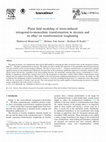
This paper proposes a two-dimensional elastic phase field model for capturing the effect of exter... more This paper proposes a two-dimensional elastic phase field model for capturing the effect of external stress on the tetragonal-to-monoclinic (T ! M) phase transformation in zirconia. The model was able to predict the sensitivity of the monoclinic microstructural formation and evolution to the external loading conditions. The effect of stress on the T ! M phase transformation was captured by explicitly applying stresses on the computational domain by entering them in the mechanical equilibrium equations as boundary conditions. Simulation results showed that, regardless of the stress loading direction, the monoclinic twinning plane always corresponded to {1 0 0} m . Results of simulations showed that external stress favors the production of monoclinic variants which exhibit transformation strains aligned with the applied stress direction. When applied to the transformation toughening phenomenon in zirconia, the model was able to elucidate the mechanisms of phase transformation ahead of a crack tip, including the generation of a compressive stress field responsible for the retardation of further crack growth. This work presents the first model capable of demonstrating the process of transformation toughening and crack closure in zirconia.
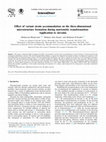
Acta Materialia, 2015
This paper computationally investigates the effect of martensitic variant strain accommodation on... more This paper computationally investigates the effect of martensitic variant strain accommodation on the formation of microstructural and topological patterning in zirconia. We used the phase-field technique to capture the temporal and spatial evolution of embryonic formation of the monoclinic phase in tetragonal single crystals. The three-dimensional simulations were able to capture the formation of all the possible monoclinic variants. We used the multivariant single embryo as an initial condition to mitigate the lack of nucleation criteria at the mesoscale. Without a priori constraint, the model can select the transformation path and final microstructure. The phase-field model was benchmarked against experimental studies on surface uplift formation in zirconia reported by Deville et al. (Acta Mater 2004;52:5697, Acta Mater 2004;52:5709). The simulations showed the excellent capabilities of the model in predicting the formation of a surface relief induced by the tetragonal to monoclinic martensitic transformation.
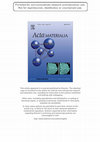
TMS/TMS2013, 2013
The allotropic phase transformation in zirconia from the tetragonal to monoclinic double lattices... more The allotropic phase transformation in zirconia from the tetragonal to monoclinic double lattices is known to occur by a martensitic twinning mechanism which shows a complex dependence on temperature, stress and environment. This paper is concerned with the development of a phase field model which accounts for the main metallurgical mechanisms governing this martensitic transition. The symmetry reduction and orientation relationship between the parent and product phases were simulated using several non-conserved order parameters representing different transformation paths. Inhomogeneous and anisotropic elastic properties were considered to determine the resultant elastic stresses. Governing equations of the tetragonal-to-monoclinic transformation were solved in a finite element framework under a variety of initial and boundary conditions. It was shown that applying different initial conditions, such as seed embryo or random, did not change the twinning patterns or the final volume fractions of the parent and product phases after the relaxation period. On the other hand, enforcing different boundary conditions resulted in completely different twinning patterns and phase volume fractions. The model was able to predict both the "V" shape morphology of twinning and the surface stress relief with "gable roof" patterns, which were observed by transmission electron microscopy and atomic force microscopy to be characteristic of the tetragonal-to-monoclinic transition.
International Journal of Plasticity, 2014
Martensitic tetragonal-to-monoclinic transformation in zirconia is a ''double-edged sword'', enab... more Martensitic tetragonal-to-monoclinic transformation in zirconia is a ''double-edged sword'', enabling transformation toughening or shape memory effects in favorable cases, but also cracks and phase degradation in undesirable scenarios. In stressed polycrystals, the transformation can burst from grain to grain, enabling stress field shielding and toughening in an autocatalysis fashion. This transformation strain can be recovered by an adequate thermal cycle at low temperatures (when monoclinic is stable) to provide a shape memory effect, or by unloading at higher temperatures (when tetragonal is stable) to provide pseudoelasticity.
International Journal of Impact Engineering, 2011
International Journal of Impact Engineering, 2010
An analytical model has been developed in this paper for the ballistic impact behavior of twodime... more An analytical model has been developed in this paper for the ballistic impact behavior of twodimensional woven fabric composites of interest in body armor applications.
Computational Materials Science, 2013
In the last few decades, the phase field method has shown tremendous capabilities of predicting m... more In the last few decades, the phase field method has shown tremendous capabilities of predicting microstructure evolutions at the mesoscale scale. This method was widely used for modeling martensitic phase transformation, where the displacive character was a challenging problem for the counterpart sharp interface approach. Martensitic phase transformation, which is an invariant plane stress twinning, drives a myriad of phase transition phenomena of paramount importance to many structural applications. This article provides a literature review of the past phase field modeling studies used to capture the formation and growth of martensite.
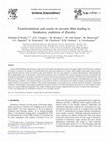
Acta Materialia, 2013
Using combined Raman spectroscopy, atomic force microscopy and optical microscopy, this paper sug... more Using combined Raman spectroscopy, atomic force microscopy and optical microscopy, this paper suggests that breakaway oxidation of Zircaloy is caused by the change of circumferential stress sign from compressive to tensile, which triggers catastrophic cracks to propagate from the oxide free surface toward the oxide-metal interface. The stress sign changes at a critical oxide thickness, which depends on the circumferential stress at the interface. This biaxial interfacial stress is promoted by a lattice expansion stress that accompanies the tetragonal to monoclinic crystal phase transition. In contrast with current research in the literature, this allotropic transformation is suggested to be beneficial, not detrimental, because it contributes to retard the thresholds for the change of circumferential stress sign, and thus breakaway oxidation. The tetragonal phase was revealed to localize at the interface and adopt the shape of prismatic isosceles triangles detected at early stages of oxidation. These growth morphologies are consistent with a cationic oxidation mechanism. Upon phase transition, the monoclinic variant quickly dominates the oxide scale above the interfacial regions and forces the overall oxidation to proceed by an anionic diffusion mechanism. The results of Raman spectroscopy compared well with those of atomic force microscopy.
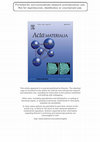
Acta Materialia, 2013
The allotropic phase transformation in zirconia from the tetragonal to monoclinic double lattices... more The allotropic phase transformation in zirconia from the tetragonal to monoclinic double lattices is known to occur by a martensitic twinning mechanism which shows a complex dependence on temperature, stress and environment. This paper is concerned with the development of a phase field model which accounts for the main metallurgical mechanisms governing this martensitic transition. The symmetry reduction and orientation relationship between the parent and product phases were simulated using several non-conserved order parameters representing different transformation paths. Inhomogeneous and anisotropic elastic properties were considered to determine the resultant elastic stresses. Governing equations of the tetragonal-to-monoclinic transformation were solved in a finite element framework under a variety of initial and boundary conditions. It was shown that applying different initial conditions, such as seed embryo or random, did not change the twinning patterns or the final volume fractions of the parent and product phases after the relaxation period. On the other hand, enforcing different boundary conditions resulted in completely different twinning patterns and phase volume fractions. The model was able to predict both the "V" shape morphology of twinning and the surface stress relief with "gable roof" patterns, which were observed by transmission electron microscopy and atomic force microscopy to be characteristic of the tetragonal-to-monoclinic transition.
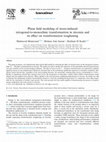
Acta Materialia, 2014
This paper proposes a two-dimensional elastic phase field model for capturing the effect of exter... more This paper proposes a two-dimensional elastic phase field model for capturing the effect of external stress on the tetragonal-to-monoclinic (T ! M) phase transformation in zirconia. The model was able to predict the sensitivity of the monoclinic microstructural formation and evolution to the external loading conditions. The effect of stress on the T ! M phase transformation was captured by explicitly applying stresses on the computational domain by entering them in the mechanical equilibrium equations as boundary conditions. Simulation results showed that, regardless of the stress loading direction, the monoclinic twinning plane always corresponded to {1 0 0} m . Results of simulations showed that external stress favors the production of monoclinic variants which exhibit transformation strains aligned with the applied stress direction. When applied to the transformation toughening phenomenon in zirconia, the model was able to elucidate the mechanisms of phase transformation ahead of a crack tip, including the generation of a compressive stress field responsible for the retardation of further crack growth. This work presents the first model capable of demonstrating the process of transformation toughening and crack closure in zirconia.




Uploads
Papers by Mahmood Mamivand